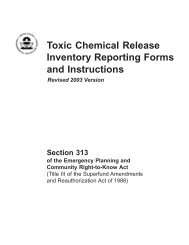Sample Program - Confined Space - Construction - Seton
Sample Program - Confined Space - Construction - Seton
Sample Program - Confined Space - Construction - Seton
Create successful ePaper yourself
Turn your PDF publications into a flip-book with our unique Google optimized e-Paper software.
A common confined space found in the construction of nuclear power plants is the<br />
condenser pit. Because of their large size, they are often overlooked as potentially<br />
hazardous confined spaces. These below grade areas create large containment areas for<br />
the accumulation of toxic fumes, gases, and so forth, or for the creation of oxygen<br />
deficient atmospheres when purging with argon, freon, and I other inert gases. Workers<br />
above dropping equipment, tools, and materials into the pit will create other hazards.<br />
Manholes<br />
Throughout the construction site, manholes are commonplace. As means of entry into and<br />
exit from vaults, tanks, pits, and so forth, manholes perform a necessary function.<br />
However, these confined spaces may present serious hazards, which could cause injuries<br />
and fatalities. A variety of hazards are associated with manholes. To begin with, the<br />
manhole could be a dangerous trap into which the worker could fall. Often covers are<br />
removed and not replaced, or else they are not provided in the first place.<br />
Pipe Assemblies<br />
One of the most frequently unrecognized types of confined spaces encountered<br />
throughout the construction site is the pipe assembly. Piping of sixteen to thirty-six<br />
inches in diameter is commonly used for a variety of purposes. For any number of<br />
reasons, workers will enter the pipe. Once inside, they are faced with potential oxygen<br />
deficient atmospheres, often caused by purging with argon or another inert gas. Welding<br />
fumes generated by the worker in the pipe, or by other workers operating outside the pipe<br />
at either end, subject the worker to toxic atmospheres. The generally restricted<br />
dimensions of the pipe provide little room for the workers to move about and gain any<br />
degree of comfort while performing their tasks. Once inside the pipe, communication is<br />
extremely difficult. In situations where the pipe bends, communication and extrication<br />
become even more difficult. Electrical shock is another problem to which the worker is<br />
exposed. Ungrounded tools and equipment or inadequate line cords are some of the<br />
causes. As well, heat within the pipe run may cause the worker to suffer heat prostration.<br />
Ventilation Ducts<br />
Ventilation ducts and pipe runs are very common at the construction site. These sheet<br />
metal enclosures create a complex network, which moves heated and cooled air and<br />
exhaust fumes to desired locations in the plant. Ventilation ducts may require that<br />
workers enter them to cut out access holes, install essential parts of the duct, etc.<br />
Depending on where these ducts are located, oxygen deficiency could exist. They usually<br />
possess many bends, which create difficult entry and exit and which also make it difficult<br />
for workers inside the duct to communicate with those outside it. Electrical shock hazards<br />
and heat stress are other problems associated with work inside ventilation ducts.<br />
Tanks
















